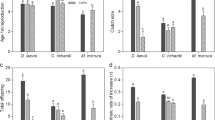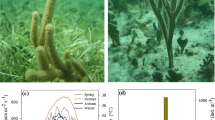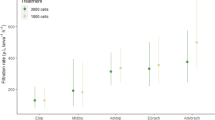Abstract
Algal food density is known to influence life history variables of cladoceran species. It is not, however, well established whether both littoral and planktonic cladocerans show similar trends when exposed to increasing food concentrations. In the present work, we studied the life table demography of four cladoceran species (Ceriodaphnia cornuta, Moina macrocopa, Pleuroxus aduncus and Simocephalus vetulus) in relation to three algal food concentrations (low: 0.5 × 106, medium: 1.5 × 106 and high: 4.5 × 106 cells ml−1 of Chlorella vulgaris) (in terms of carbon content, these were equivalent to 0.15, 0.45 and 1.35 μg ml−1, respectively) at 25 °C. In general, for all the tested cladoceran species, values of average lifespan, gross reproductive rate, net reproductive rate, generation time and the rate of population growth were higher at lower food concentrations. Furthermore, high food concentration resulted in a negative population growth rate (mean ± standard error: −0.091 ± 0.026) for P. aduncus. The highest population growth rate (0.602 ± 0.014) was recorded for M. macrocopa at low food density. S. vetulus had the longest average lifespan (40 ± 1 d) while M. macrocopa had the lowest (5 ± 1 d). C. cornuta showed better performance at medium food concentration. We conclude that among the algal concentrations used here, 0.5 × 106 – 1.5 × 106 was beneficial not only to the planktonic species but also to the littoral P. aduncus and S. vetulus while 4.5 × 106 cells ml−1 was unsuitable for all the cladocerans tested.
Similar content being viewed by others
References
Allan, J. D. & C. E. Goulden, 1980. Some aspects of reproductive variation among freshwater zooplankton. In Kerfoot, W. C. (ed.), Ecology and Evolution of Zooplankton Communities, University Press of New England, Hanover, New Hampshire: 388–410.
Anonymous, 1985. Methods of measuring the acute toxicity of ef-fluents to freshwater and marine organisms. US Environment Protection Agency EPA/600/4-85/013.
Borowitzka, M. A. & L. J. Borowitzka, 1988. Micro-algal Biotechnology. Cambridge University Press, London.
DeMott, W. R., 1989. The role of competition in zooplankton succession. In Sommer, U. (ed.), Plankton Ecology: Succession in Plankton Communities. Springer, New York: 195–252.
Dodson, S. I. & D. G. Frey, 1991. Cladocera and other Branchiopoda. In: Ecology and Classification of North American Freshwater Invertebrates. Academic Press, New York: 723–786.
Downing, J. A. & F. H. Rigler (eds), 1984. A Manual on the Methods for the Assessment of Secondary Productivity in Fresh Waters. IBP Handbook 17, Blackwell Scientific Publ., London.
Dumont, H. J., J. G. Tundisi & K. Roche (eds), 1990. Intrazooplankton Predation. Developments in Hydrobiology 60. Kluwer Academic Publishers, Dordrecht: 250 pp. Reprinted from Hydrobiologia 198.
Glazier, D. S., 1992. Effects of food, genotype and maternal size and age on offspring investment in in Daphnia magna. Ecology 73: 910–926.
Gliwicz, Z. M., 1990. Food thresholds and body size in cladocerans. Nature 343: 638–640.
Gulati, R. D. & W. R. DeMott (eds), 1997. The Role of Food Quality for Zooplankton. Freshwat. Biol. 38: 447-771.
King, C. E., 1982. The evolution of lifespan. In Dingle, H. & J. P. Hegmann (eds), Proceedings in Life Sciences: Evolution and Genetics of Life Histories. Springer-Verlag, New York: 121–138.
Lampert, W. & U. Schober, 1980. The importance of 'threshold' food concentrations. In Kerfoot, W. C. (ed.), Evolution and Ecology of Zooplankton Communities. University Press of New England, Hanover, New Hampshire: 264–267.
Lampert, W. & U. Sommer, 1997. Limnoecology: the Ecology of Lakes and Streams. Oxford University Press, New York: 382 pp.
Lynch, M., 1980. The evolution of cladoceran life histories. Q. Rev. Biol. 55: 23–42.
Nandini, S. & T. R. Rao, 1998. Somatic and population growth in selected cladoceran and rotifer species offered the cyanobacterium Microcystis aeruginosa as food. Aquat. Ecol. 31: 283–298.
Pianka, E. R., 1988. Evolutionary ecology. Harper & Row, New York, 3rd edn: 468 pp.
Porter, K. G., J. Gerritsen & J. D. Orcutt, Jr., 1982. The effect of food concentration on swimming patterns, feeding behaviour, ingestion, assimilation and respiration by Daphnia. Limnol. Oceanogr. 27: 935–949.
Robertson, A. L., 1990. Population dynamics of Chydoridae and Macrothricidae (Cladocera: Crustacea) from the River Thames, U.K. Freshwat. Biol. 24: 375–389.
Romanovsky, Y. E., 1985. Food limitation and life history strategies in cladoceran crustaceans. Ergebn. Limnol. 21: 363–372.
Rothhaupt, K. O., 1988. Mechanistic resource competition theory applied to laboratory experiments with zooplankton. Nature 333: 660–662.
Sarma, S. S. S., M. A. Fernández-Araiza & S. Nandini, 1999. Competition between Brachionus calyciflorus Pallas and Brachionus patulus (Müller) (Rotifera) in relation to algal food concentration and initial population density. Aquat. Ecol.
Sarma, S. S. S. & T. R. Rao, 1991. The combined effects of food and temperature on the life history parameters of Brachionus patulus Muller (Rotifera). Int. Rev. ges. Hydrobiol. 76: 225–239.
Sommer, U. (ed.), 1989. Plankton Ecology: Succession in Plankton Communities. Springer, New York.
Stearns, S. C., 1976. Life history tactics: a review of ideas. Q. Rev. Biol. 51: 3–47.
Stemberger, R. S. & J. J. Gilbert, 1985a. Assessment of threshold food levels and population growth in planktonic rotifers. Ergebn. Limnol.. 21: 269–275.
Stemberger, R. S. & J. J. Gilbert, 1985b. Body size, food concentration and population growth in planktonic rotifers. Ecology 66: 1151–1159.
Vanni, M. J. & W. Lampert, 1992. Food quality effects on life history traits and fitness in the generalist herbivore Daphnia. Oecologia 92: 48–57.
Author information
Authors and Affiliations
Corresponding author
Rights and permissions
About this article
Cite this article
Nandini, S., Sarma, S.S.S. Lifetable demography of four cladoceran species in relation to algal food (Chlorella vulgaris) density. Hydrobiologia 435, 117–126 (2000). https://doi.org/10.1023/A:1004021124098
Issue Date:
DOI: https://doi.org/10.1023/A:1004021124098




